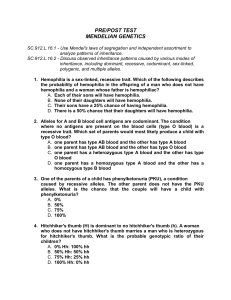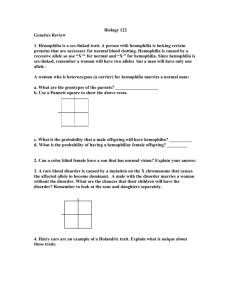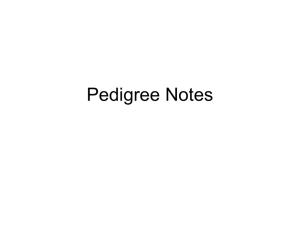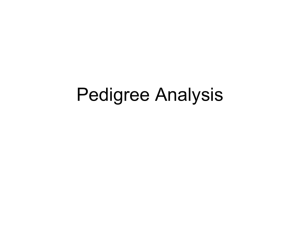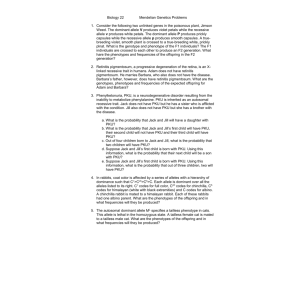Genetics
advertisement
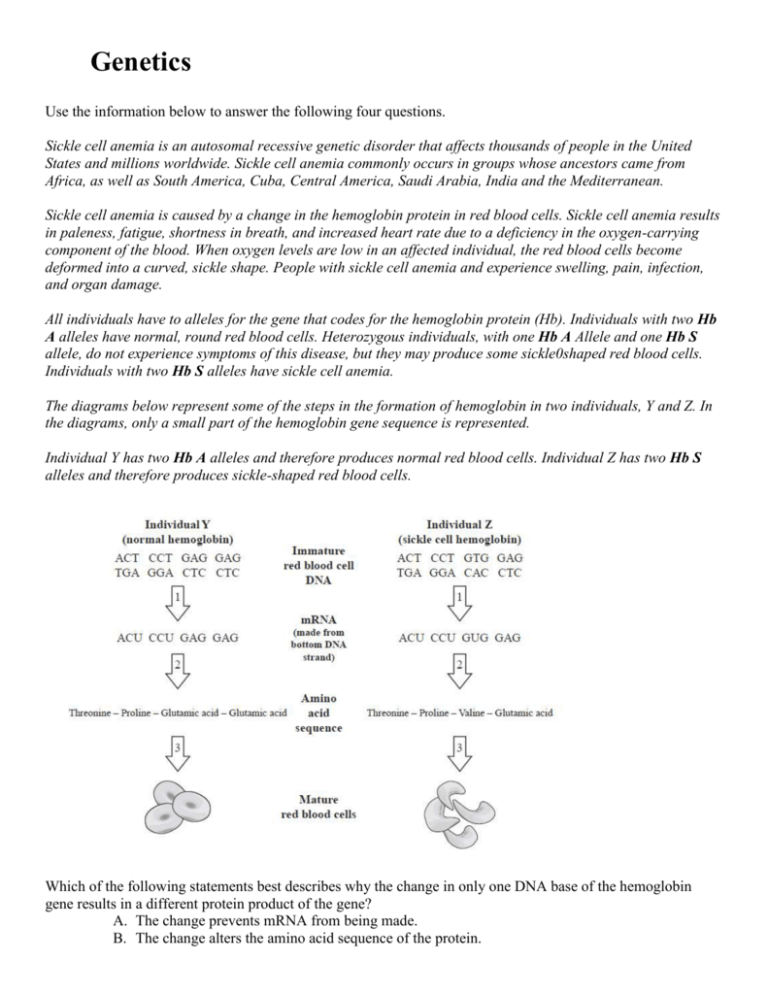
Genetics Use the information below to answer the following four questions. Sickle cell anemia is an autosomal recessive genetic disorder that affects thousands of people in the United States and millions worldwide. Sickle cell anemia commonly occurs in groups whose ancestors came from Africa, as well as South America, Cuba, Central America, Saudi Arabia, India and the Mediterranean. Sickle cell anemia is caused by a change in the hemoglobin protein in red blood cells. Sickle cell anemia results in paleness, fatigue, shortness in breath, and increased heart rate due to a deficiency in the oxygen-carrying component of the blood. When oxygen levels are low in an affected individual, the red blood cells become deformed into a curved, sickle shape. People with sickle cell anemia and experience swelling, pain, infection, and organ damage. All individuals have to alleles for the gene that codes for the hemoglobin protein (Hb). Individuals with two Hb A alleles have normal, round red blood cells. Heterozygous individuals, with one Hb A Allele and one Hb S allele, do not experience symptoms of this disease, but they may produce some sickle0shaped red blood cells. Individuals with two Hb S alleles have sickle cell anemia. The diagrams below represent some of the steps in the formation of hemoglobin in two individuals, Y and Z. In the diagrams, only a small part of the hemoglobin gene sequence is represented. Individual Y has two Hb A alleles and therefore produces normal red blood cells. Individual Z has two Hb S alleles and therefore produces sickle-shaped red blood cells. Which of the following statements best describes why the change in only one DNA base of the hemoglobin gene results in a different protein product of the gene? A. The change prevents mRNA from being made. B. The change alters the amino acid sequence of the protein. C. The change causes the blood cells to divide in a uncontrolled way. D. The change creates a second strand of mRNA for each RNA molecule. 2. Which of the following cell structures carries out the process represented by the arrows labeled “2” in the diagrams? A. Mitochondrion B. Nucleus C. Ribosome D. Vacuole 3. Which of the following statements best summarizes a change that is represented by the arrows labeled “3” in the diagrams? A. A nucleus is formed in each cell. B. Each cell divides to form two daughter cells. C. A chain of amino acids is folded to form a protein in each cell. D. Proteins are transported through the plasma membrane of each cell. 4. Which of the following statements best compares individual Y and individual Z in terms of genotype and phenotype? A. The individuals have the same genotype and phenotype. B. The individuals have the same genotype but different phenotypes. C. The individuals have different genotypes but the same phenotype. D. The individuals have different genotypes and phenotypes. 5. An inherited metabolic disorder called phenylketonuria (PKU) can result in serious problems in infancy. The chance that two parents who are heterozygous will have a child with PKU is 25%. Which of the following terms best applies to the inheritance pattern for PKU? A. Codominant B. Dominant C. Recessive D. Sex-linked 6. Which of the following terms applies to traits, such as human eye color, that are controlled by more than one gene? a. b. c. d. co-dominate polygenic recessive sex-linked 7. In pigeons, allele B produces ash-red feathers. The allele b produces blue feathers. The B allele is dominant to the b allele. A pigeon with genotype Bb is crossed with a pigeon with genotype bb. What percent of the offspring are expected to have ash-red feathers? a. b. c. d. 0% 25% 50% 100% 8. In humans, freckles are encoded by a dominant allele. An individual woman is heterozygous for freckles.According to the law of segregation, which of the following would apply to a child of this woman? a. The child must inherit the dominate allele for freckles b. The child must inherit the recessive allele for freckles c. The child has an equal chance of inheriting the dominate allele or the recessive allele for freckles from her mother. d. The child has a greater chance of inheriting the dominate allele than the recessive allele for freckles from her mother. 9. In pea plants, the allele for purple flowers (P) is dominant to the allele for white flowers (p). A plant that is heterozygous for purple flowers is crossed with a plant with white flowers. What percentage of the offspring plants are expected to have purple flowers? a. b. c. d. 10. Hemophilia is an X-linked recessive condition in which blood does not clot properly. Queen Victoria of England had one allele for hemophilia. Which of the following statements describes the most likely pattern for the occurrence of hemophilia in Queen Victoria’s descendants? a. b. c. d. 11. All of Queen Victoria’s children had hemophilia. All of Queen Victoria’s children were carriers for hemophilia. Female descendants of Queen Victoria could not pass on the gene for hemophilia. More male descendants than female descendants of Queen Victoria had hemophilia. In pea plants, the genes used for seed color and seed shape are on different chromosomes. Which of the following explains why the genes for these traits are not inherited together? a. b. c. d. 12. 25% 50% 75% 100% natural selection artificial selection the law of segregation the law of independent assortment A pedigree showing the inheritance of a gold dorsal stripe pattern in ball pythons in shown below. According to the pedigree, what type of trait is this stripe pattern in ball pythons? a. b. c. d. 13. A hereditary muscular disease in horses causes abnormal opening and closing of the sodium ion channels in the muscle cells. Which of the following statements describes the most likely origin of this disease? a. b. c. d. 14. A virus evolved specifically to attack the muscle cells of horses. Motor neurons near some of the muscle cells degenerated over time. High levels of sodium in the blood irreversibly damaged the ion channels. A mutation occurred in the gene coding for the sodium ion channel protein. In rabbits, a single gene controlling coat color has four alleles. The inheritance pattern for coat color in rabbits is therefore best described as which of the following? a. b. c. d. 15. Co-dominate polygenic recessive sex-linked Multiple allele Polygenic Recessive Sex-linked Two chromosome pairs from a diploid organism are shown below. Assuming meiosis and fertilization occur normally, which of the following pairs of alleles can an offspring receive from this parent? a. b. c. d. A and A A and a A and f F and F 16. Below is a pedigree of Duchenne muscular dystrophy (DMD). Shaded squares and circles represent the disease being expressed. The dots in the circles and squares represent carriers of DMD. The line through the circles and squares represents death. What type of disease is this? A. B. C. D. Autosomal dominant Autsomal recessive Sex Linked Acquired 17. Vestigial wings on a fruit fly is an autosomal recessive trait showing that the wings are so small they do not function. White eyes in a fruit fly is a sex linked trait. Determine the answers to the question below. What is the genotype of the parents if 50% of the females have white eyes and 50% of the males have white eyes? a. b. c. d. e. Mom is XwXwand father is XwYw Mom is XXand father is XwY Mom is XwXand father is XwY Mom is XwXwand father is XY Mom is XXwand father is XYw 18. Based off of information from Question 64, what is the genotype of the parents if 75% of the offspring have vestigial wings? a. b. c. d. NN x Nn Nn x nn nn x nn Nn x Nn 19. PKU is an Autosomal recessive trait that affects all races. Affected individuals have a mutated enzyme that prevents the breakdown of the amino acid phenylalanine. If two parents are carriers for having the trait, what are the chances of their child having PKU? How many will be carriers? A. B. C. D. 25% will have PKU, 50% will be carriers, 25% will not carry the trait 50% will have PKU, 50% will be carriers 75% will have PKU, 25% will be carriers 100% will have PKU, none will be carriers 20. From the pedigree below indicate if the trait is Autosomal recessive, Autosomal dominant, or sex linked, incomplete dominance. A. B. C. D. Recessive Sex Linked Incomplete dominance dominant The picture to the right clearly shows two guinea pigs in love. Short hair is dominant to long hair. The male is long haired (ss) and the female is (SS). SS x ss 21. How many of their offspring will be long haired? A. 25% B. 50% C. 75% D. 100% E. 0% 22. If the female was Ss x and the male was ss, how many offspring will be long haired? A. B. C. D. E. 25% 50% 75% 100% 0% 23. A checkered chicken is a chicken that has ½ of its feathers black and ½ of its feathers white. What does this indicate? A. B. C. D. Incomplete dominance Sex-linked Co-dominance Autosomal Recessive 24. In snap dragon flowers, the genotype is RR for red flower, WW for a white flower and RW for a pink flower. What does the pink flower indicate about the trait? A. B. C. D. Incomplete dominance Sex-linked Co-dominance Autosomal Recessive 25. In snap dragon flowers, the genotype is RR for red flower, WW for a white flower and RW for a pink flower. What are the phenotypes of the offspring if you cross two pink snap dragons? A. B. C. D. 25% red, 25% white, 50% pink 75% red, 25% white, 0% pink 25% red, 50% white, 25% pink 0% red, 25% white, 50% pink 26. From the genetic diseases listed below, determine which disorder matches the disease Down Syndrome A. B. C. D. Turner’s Syndrome Trisomy 21 = Down Syndrome, Trisomy 21 = Turner’s Syndrome Trisomy 21 = DNA mutation Trisomy 21 = Turner’s Syndrome PKU XO = Turner’s Syndrome XO = Down Syndrome, XO = Turner’s Syndrome, XO = DNA mutation PKU= DNA mutation PKU= DNA mutation PKU= Down Syndrome PKU= Down Syndrome

